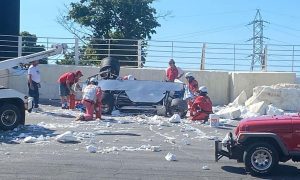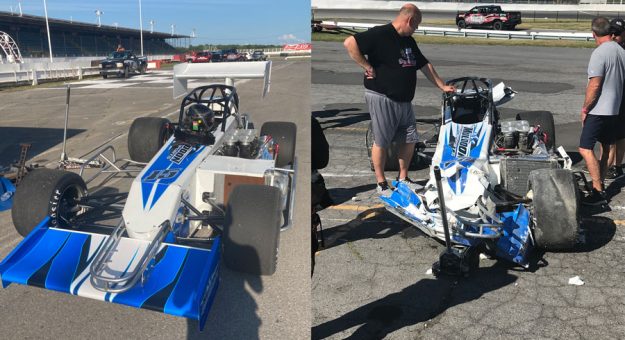OSWEGO, N.Y. — There are two types of racers in auto racing: those who hit the wall and those who are about to hit the wall.
I discovered that this past weekend in the monstrous supermodifieds at Oswego Speedway.
It was a race weekend that was going well before I got flipped on my head.
During the second practice session things went upside down, literally.
I was exiting turn four heading down the straightaway into turn one when I lifted just before the start/finish line and started to brake into the corner. When I did this, the front of the car seemed to fall down and collapse, as if it had lost weight-bearing support from the suspension.
In that moment though, all I knew and could feel was that the brakes weren’t slowing the car down and turning the wheel wasn’t doing anything either. I could feel a vibration emanating from the front right of the car.
It was only a moment later when I knew I was going to hit the wall.
I took my hands off the wheel right as the car was beginning to impact to avoid the inevitable wrist and hand-wrenching jerk and locked my arms to my chest in a cross position as fast as possible as I felt the orientation of the car go from right-side up to upside down.

The car did a full 180 spin in the air as it inverted and then landed, facing the frontstretch grandstands. I took a moment to assess the damage, not having felt any pain from the impact itself, and concluded, “That was a wild ride.”
The safety crew rushed over to try and get me flipped over but determined that I had better get out of the car while it was still upside down. I was grateful for that because I didn’t really like some of the fumes I was inhaling.
With their help, I unbuckled and climbed swiftly from the car.
I went back and debriefed about what I felt in the moment, concluding that something must have broken in the right front, and that was that.
The weekend came to an early and dramatic close in a plume of Styrofoam block that some people refer to as the “snow blizzard.”
This time, I was much less bummed overall because I wasn’t the cause of my weekend-ending incident, and that was pretty much the only solace to be garnered from the situation, besides the fact that I got a semi-viral video of me nonchalantly reacting to one of the biggest crashes of my career.
Despite the fact that I seem incapable of actually making my debut in the big-block supermodified, I developed comfort and confidence in the car. If I could have magically transformed the car back to 100 percent, I would have done so immediately after the crash and gone back out for qualifying and raced that night.
I feel bad for the guys, especially the Muldoons, after all their hard work going into the car, but as soon as we get the car back in tip-top shape I’m confident we’ll be back out with it as soon as possible.
Prior to that, the weekend at Oswego Speedway was going very well.
I got more comfortable with the car during Friday’s practice. I was able to focus on speed out of the exit of turns two and four. I got down to a 16.98 seconds on older tires on a setup that was designed to make me feel more comfortable with pushing the limits, a time that is around a tenth off my best time so far.
Heading into Saturday, I was feeling pretty confident in my slow but steady progression.
It normally doesn’t take me this long to get up to pace in a new or unfamiliar car. I’m able to find the limit of the car pretty quickly. I start to understand fairly quickly what the limit of the car is and how I can drive it faster, and it’s because I’m able to go over the limit with a good amount of confidence that the car will stay within my control.
However, the supermodified is different.
In the supermodified, if you go over the limit, even if it’s just two or three percent, there is no guarantee that the car is coming back from that experiment in one piece.
On a road course you have grass or runoff, and really in any other short track car — both dirt and pavement — you have more time to react to the tires going past their capabilities.
The supermodified doesn’t give you really any time at all to react and the cockpit is so small that you don’t really have any counter-steering leverage in the first place. Everything happens faster in the car in general, which means you have to be even more careful not to overstep the limit.
All this being said, I was still working up to the limit on Saturday during first practice, being purposefully conservative on the entry of turns one and three so I could focus on my comfortability with the car mid-corner and exit.
I reached the limit of the car’s mid-corner and exit ability, so we loosened up the car some more heading into practice two.
And that is when my weekend went upside-down.
